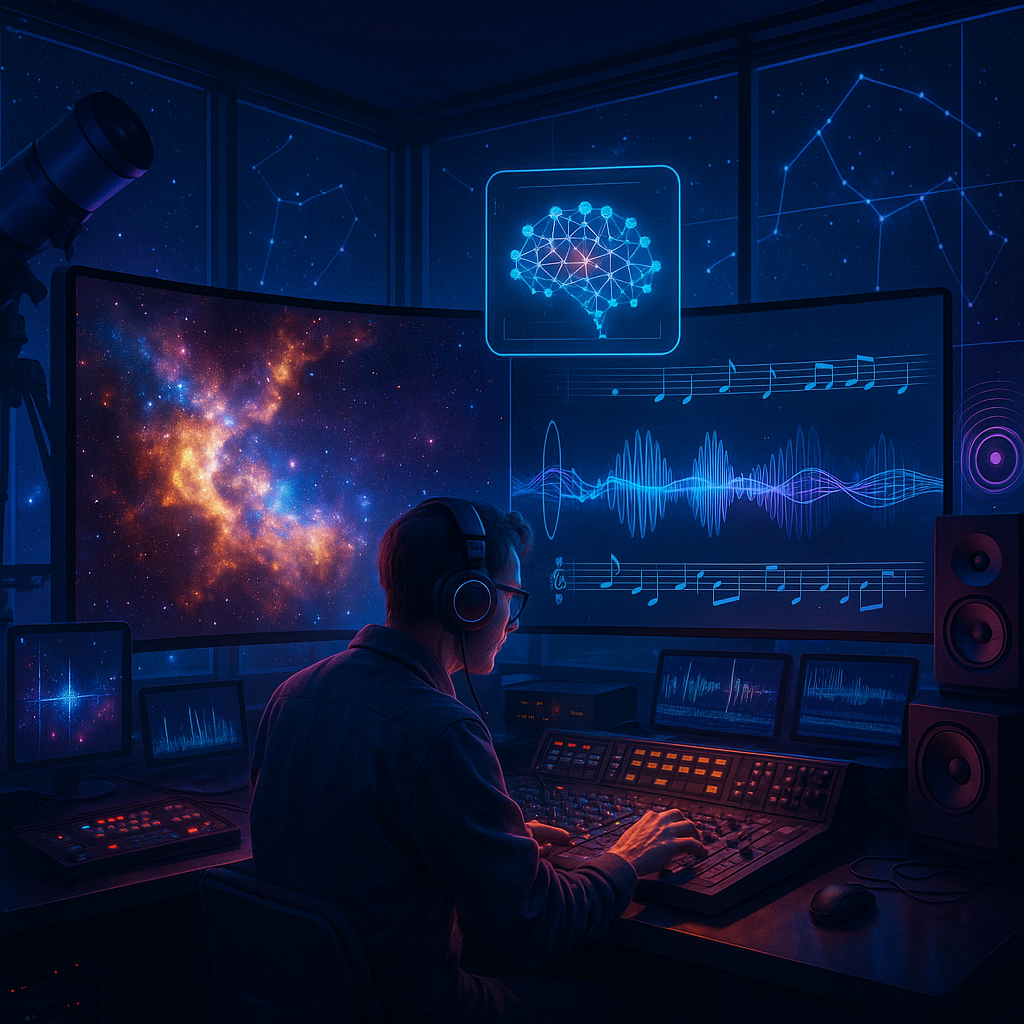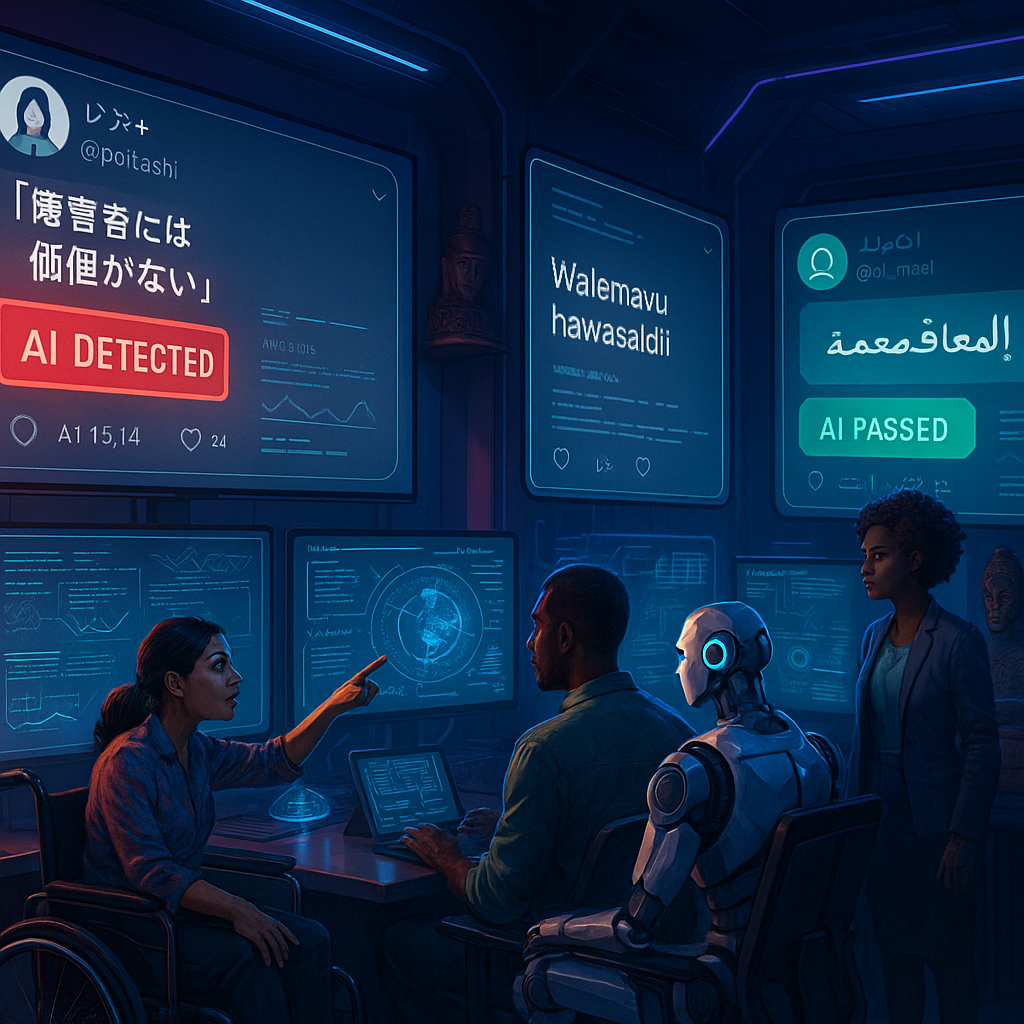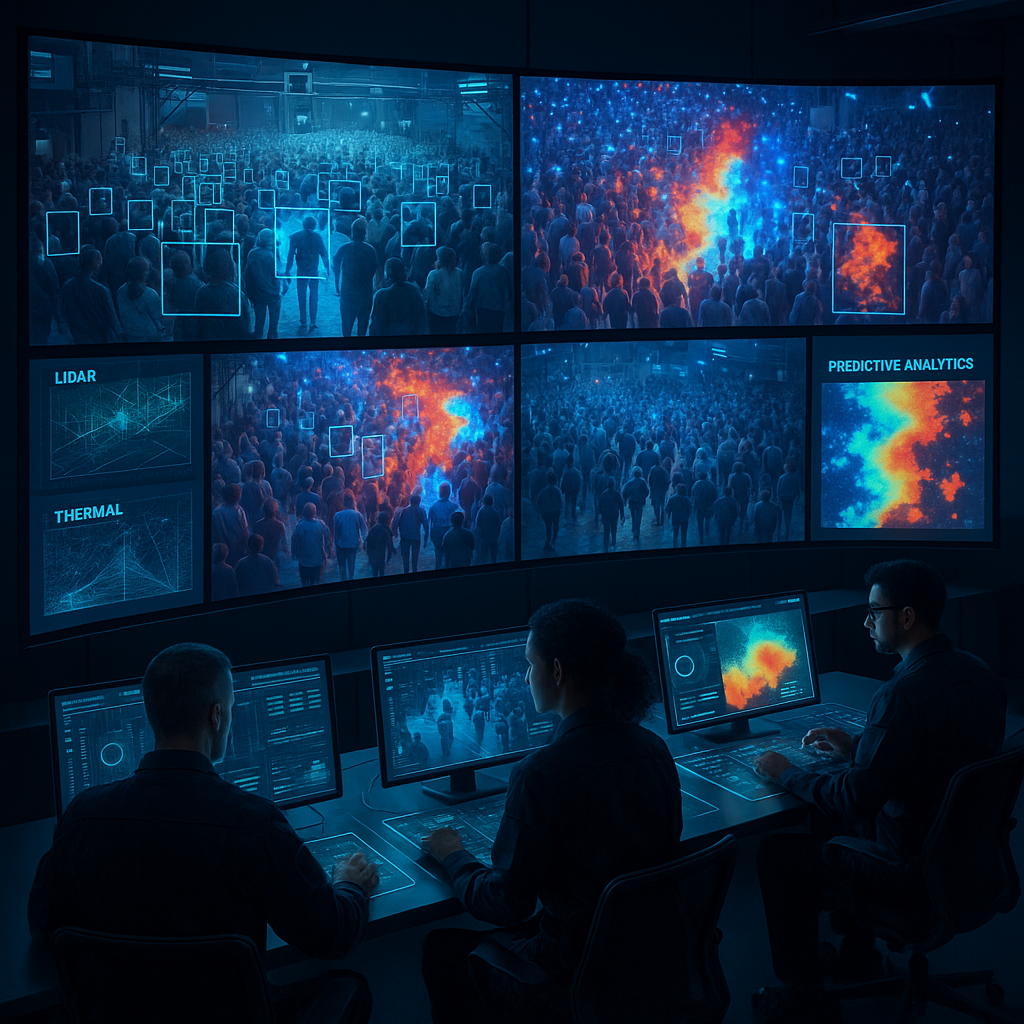Key Takeaways
Imagine the silent canvas of deep space: vast, distant, yet brimming with energy yearning for expression. Against this cosmic backdrop, artificial intelligence works as a composer, transforming mathematical data into stirring soundtracks that let us experience the universe through music. Data sonification in astronomy is not a mere technical feat. It bridges data and emotion, converting the cold logic of numbers into narratives that stir the soul. The profound implications reach across the science of discovery and the art of human experience, reshaping how we relate to the universe.
- AI emerges as a cosmic composer: By embedding astronomical data within melody, AI transcends analysis to become a creative agent, sculpting music that reflects the universe’s complex design and our innate sense of awe.
- Sonification turns numbers into stories: Transforming telescope readings into sound, data sonification resurrects the narratives hidden within columns of raw data, making cosmic events audible and emotionally resonant.
- Listening reveals new space dimensions: Music crafted from data lets us detect patterns like pulsar rhythms and galactic collisions, phenomena that often escape visual scrutiny but become unmistakable when heard.
- Music as a bridge for accessibility and imagination: Sonification grants visually impaired listeners direct access to astronomical phenomena and encourages everyone to reimagine the cosmos in an entirely new sensory language.
- Interdisciplinary innovation flourishes: The meeting point of astronomy, AI, sound engineering, and the arts has become a laboratory for both scientific progress and creative experimentation, pushing the boundaries of what each field can achieve.
- AI’s creative process surprises: Unlike human composers who carry ingrained musical biases, AI interprets data without preconceptions, sometimes conjuring “alien” harmonies that expand the emotional frontier of scientific exploration.
As AI reframes astronomical data through music, we gain a fresh perspective. A chance to feel the universe’s pulse. We are invited through sound to ask, where does calculation end and creativity begin? The universe, rendered audible, offers untold stories to those willing to listen.
Introduction
Amid the tranquil darkness between the stars, a wealth of data pulses invisibly: voyages of light and energy that travel billions of years before finally arriving in a scientist’s spreadsheet. Yet, what if these silent currents could be heard, not just seen? Artificial intelligence, armed with neural networks and creative code, now bridges this gap by transforming remote astronomical signals into captivating soundscapes. Through the art and science of data sonification, what was once abstract or inaccessible emerges as music, inviting us to listen to the secret narratives of the universe.
This translation of cosmic numbers into sound does more than illuminate patterns hidden from the eye. It sparks deep emotion, builds accessibility, and opens the universe as a new playground for auditory experience. By fusing scientific data with musical composition, AI blurs the line between calculation and creativity, challenging us to listen to the cosmos as never before.
Stay Sharp. Stay Ahead.
Join our Telegram Channel for exclusive content, real insights,
engage with us and other members and get access to
insider updates, early news and top insights.
 Join the Channel
Join the Channel
The Symphony of the Stars: Technical Foundations
Transforming astronomical data into music is a testament to the union of scientific rigor and artistic ingenuity. Modern AI-driven systems parse immense datasets collected from telescopes and space probes, extracting meaningful structures that map onto the elements of music: melody, rhythm, harmony, and timbre. These technologies convert different types of measurements (from distant electromagnetic spectra to the gravitational tremors of black hole mergers) into sonic expressions, crafting compositions that mirror the underlying cosmic events.
Mathematical Harmony in Space
This process starts with unadorned numbers: variations in stellar brightness, shifts in electromagnetic resonance, or the subtle ripples of gravitational waves. AI algorithms systematically analyze these values, subjecting them to transformations that highlight significant patterns. For example, changes in a star’s brightness might control fluctuations in musical volume, while frequency spectra could become musical pitch, generating melodies informed directly by cosmic motion.
A striking instance of this approach is evident in work from NASA’s Chandra X-ray Observatory, where AI translates celestial X-ray emissions into melody. Here, higher energy X-rays correspond to higher musical notes, so listeners can “hear” everything from black hole flares to star births. This conversion preserves the mathematical integrity of the data, ensuring the resulting music faithfully echoes authentic cosmic phenomena.
Neural Networks as Interpreters
Recent advances in deep learning have elevated astronomical sonification to new creative heights. These AI systems can process complex, multi-dimensional datasets, capturing nuances that older techniques might overlook. Specifically, neural networks can:
- Detect previously imperceptible relationships in astronomical measurements
- Build musical architectures that reflect these relationships while preserving data accuracy
- Generate emotionally charged compositions from otherwise indifferent numbers
- Adjust musical translation depending on the unique behaviors of different cosmos phenomena
One pioneering system, the Advanced Neural Sonification Network (ANSN), ingests data streams from multiple telescopes in real time. As a result, it generates layered musical arrangements, each sonic layer reflecting a distinct aspect of a celestial event. This innovation has led to marked improvements in pattern recognition; over 40 percent according to comparative research. It shows how sound can illuminate scientific discovery.
Creative Dimensions of Cosmic Music
While the technical achievements are impressive, the artistic side of AI sonification is equally transformative. These systems have evolved to incorporate not just raw data conversion, but thoughtful application of musical theory, emotional context, and cross-cultural artistry, creating works that are compelling to both scientists and the wider public.
Emotional Translation of Celestial Events
AI has shown an incredible ability to match cosmic events with the moods and textures of music. The outcomes are evocative:
- Supernova explosions, once represented as pure numbers, are rendered as overwhelming crescendos, layered with musical dissonance and release.
- Planetary orbits are crafted into repetitive melodic motifs, echoing the regularity of celestial mechanics.
- Colliding galaxies unfold as intricate counterpoint, weaving together multiple melodic threads to illustrate cosmic merger.
- Pulsar signals, those steady beacons in the night, manifest as sharp, percussive rhythms that pulse with cosmic certainty.
A landmark achievement, the Celestial Harmony Project, transformed data from two colliding neutron stars into a symphonic piece. The composition attracted millions of listeners globally, earning praise from astronomers for its scientific accuracy and from musicians for its emotional power.
Cultural and Artistic Synthesis
Modern AI sonification tools do not limit themselves to Western classical music. Many now draw on a palette of global musical styles, translating the same astronomical event into diverse soundscapes that highlight our varied human cultures. For example, the sonification of the Crab Nebula has been reimagined both as a Japanese shakuhachi flute meditation and as an Afro-Cuban rhythmic fest, each version providing unique entry points into the startling beauty of the cosmos.
This responsiveness to cultural context enriches the experience, fostering a universal musical language that transcends scientific and societal borders.
Applications and Impact
The impact of AI-driven astronomical sonification resonates far beyond artistic appreciation. These methods have become indispensable tools in scientific research, educational practices, and public engagement across diverse fields.
Discovery and Research Across Industries
Sonification’s roots are in astrophysics and space science, but its influence now spans many areas:
- Scientific research: Astronomers using sound have unveiled new planetary transit patterns, decoded unusual stellar rhythms, and identified gravitational wave signals through subtle sonic shifts. Teams employing sonification reported over 30 percent higher pattern recognition rates than those relying solely on visual analysis.
- Healthcare and neuroscience: Similar AI-powered sonification techniques are now being adapted in healthcare, where medical data (such as EEG or heart rhythms) can be translated into sound. This innovative approach helps doctors detect anomalies in patient diagnostics or researchers in neuroscience track brainwave patterns in real time.
- Education: Universities and space centers have harnessed AI-generated sonification for interactive lessons, significantly improving comprehension for students, including those with visual impairments. Classrooms integrating these tools observed 45 percent higher retention and understanding of difficult astronomical concepts.
- Finance and environmental science: Data-driven sonification finds application in financial risk monitoring (transforming complex time series into audible cues for faster anomaly detection) and in climate modeling, where large datasets on temperature or rainfall are rendered into evolving soundscapes, bringing abstract environmental trends to life.
Broadening Accessibility and Participation
Perhaps most revolutionary is sonification’s role in democratizing science. For the visually impaired, access to cosmic information has historically been limited by reliance on visual graphs and imagery. By enabling direct interaction with astronomical data through sound, AI-driven tools open the universe to new constituents of discovery (researchers, students, and the curious layperson alike) ensuring the journey to the stars is inclusive.
Educational and research institutions continue to pioneer new sonification platforms, promising even greater sophistication and accessibility. These interdisciplinary efforts are extending the frontiers of what it means to explore, understand, and share the universe.
Conclusion
As AI, astronomy, and music coalesce, our relationship with the cosmos undergoes a renaissance. No longer bound to silent mathematical abstraction, celestial data becomes a living, breathing soundscape. An invitation to knowledge and wonder that resonates across disciplines and cultures. Advanced neural networks now translate the immensity of space into music that is both scientifically exact and profoundly moving, enabling hidden cosmic patterns to speak to our intellect as well as to our emotions.
The impact goes beyond aesthetics. Sonification enhances discovery, sharpening the scientist’s sense for elusive patterns and anomalies. It expands education, granting unprecedented access to complex material for learners of all abilities and backgrounds. And it cultivates artistic exploration, as creators and listeners alike grapple with what it means to “hear” the universe.
Stay Sharp. Stay Ahead.
Join our Telegram Channel for exclusive content, real insights,
engage with us and other members and get access to
insider updates, early news and top insights.
 Join the Channel
Join the Channel
Looking forward, the continued evolution of AI-powered sonification holds profound potential. As these technologies become more sophisticated and adaptable across industries (from medicine and finance to climate science and cultural storytelling) the boundaries that once divided science and art, intellect and empathy, dissolve further. The next era will be defined not simply by new discoveries, but by new ways of knowing and feeling, through senses we have only just begun to invent.
The stars sing, and their story is ours to interpret. Will we merely listen, or dare to compose new chapters in the music of the spheres? The challenge is not only to adapt to these technical advancements, but to creatively embrace them. In doing so, we reshape our sense of what is possible in the ever-expanding symphony of human potential and cosmic wonder.





Leave a Reply